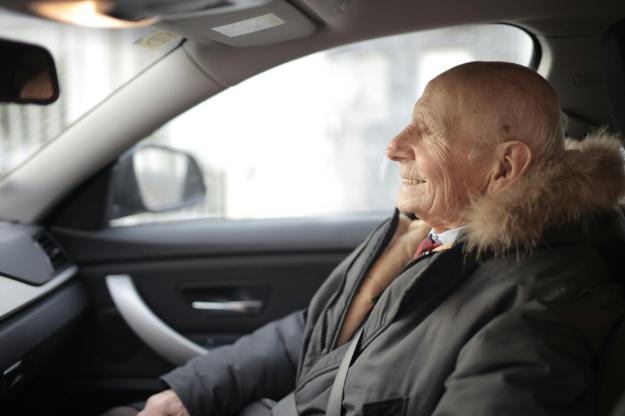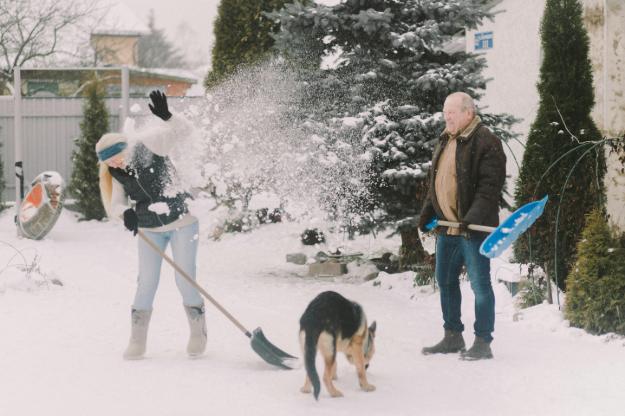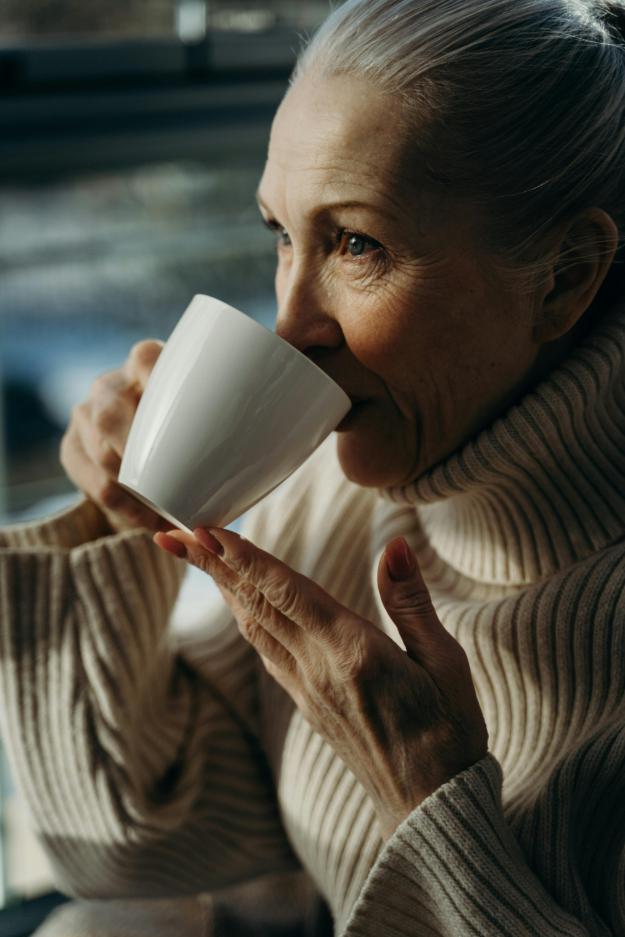Winter looks beautiful from a warm window, but let’s be honest—it’s not all cozy blankets and holiday cheer. For seniors, the cold can bring some tough challenges.
Slippery sidewalks, icy driveways, and freezing temperatures can make things tricky, especially if you’ve got health conditions like diabetes or thyroid issues. Even getting through daily tasks can feel harder in winter.
To help you stay safe this season, here are some simple winter safety tips.
Dressing Warm and Safe for Winter

1. Wear sturdy, non-slip winter shoes
Slippery sidewalks are a big problem in the winter, but the right shoes can keep you steady. Look for boots or shoes with thick treads and rubber soles that grip the ground. Waterproof shoes are a must for snowy or wet days.
Materials like Vibram rubber provide excellent traction and durability. Look for waterproof shoes to keep your feet dry in snow or slush, and opt for insulated linings to stay warm. If you need extra traction, attach ice grips or cleats—they’re easy to use and make walking on icy paths a lot safer.
2. Keep your feet warm with wool socks
Cold feet can chill your whole body. Wool socks, especially merino wool, are warm, soft, and keep your feet dry. On extra cold days, layer up—start with a thin, moisture-wicking sock (like polyester or nylon) and add a thicker wool sock for extra warmth. If you wear compression socks, top them with a light wool sock to stay warm without bulk.
Heavy winter boots? Use cushioned socks for comfort and make sure your boots aren’t too tight—cramped feet feel colder. And add insulated liners or toe warmers for extra coziness.
3. Layer up with clothes that lock in heat
Unlock your winter cabinet and pick out your warmest attire. Start with a snug base layer made of thermal or moisture-wicking fabric like polyester or wool to keep sweat away. Add a soft fleece or sweater for insulation, and top it off with a windproof, waterproof coat to block the chill.
Skip cotton—it absorbs moisture and doesn’t keep you warm when it’s wet.
4. Don’t forget hats, gloves, and scarves
Most of your body heat escapes through your head and hands, so keep them covered when heading out. A warm hat that covers your ears is a must—fleece-lined or knitted ones are super cozy. For your hands, thermal gloves are great, and if your hands run cold, heated gloves can be a game-changer.
Don’t forget a wool or fleece scarf to block those icy winds. Loop scarves are especially handy and easy to manage, even if mobility’s a challenge.
5. Stand out with bright or reflective clothing
Why not add some holiday cheer to your winter gear? A touch of sparkle or festive colors can help you stay safe on gloomy winter days. With shorter daylight hours and snow making visibility tricky, bright jackets or coats with reflective strips can help you stay visible during your farmers market trips.
If you use a walker or cane, add reflective tape for extra visibility during early mornings or evenings.
Preventing Slips and Falls Outdoors

6. Clear ice and snow from walkways
Falls are a hazard for seniors year-round, but they become even riskier when Santa comes to town. Sprinkle salt or sand on icy areas to improve traction, or try eco-friendly ice melters that are gentle on your lawn.
If shoveling isn’t an option, ask a neighbor, a family member, or hire a snow removal service to handle it for you.
7. Use the right walking aids
Use ice grippers that attach to your shoes for extra traction, or switch to a cane with an ice tip. Walkers designed for winter terrain, with sturdy wheels or non-slip feet, can also provide better stability. Make sure to test your aids on a safe surface before heading out.
Staying Warm and Cozy Indoors
8. Insulate your home against the cold
Cold drafts can sneak in, but you can seal them off with simple fixes. Use weather stripping around doors and windows, add insulating window film, and hang heavy curtains to keep the heat inside. Rugs on hardwood or tile floors help trap warmth and keep your feet cozy. If drafts persist, consider using draft stoppers for door bottoms.
9. Use heating devices safely
Place them on a flat, stable surface away from flammable materials like curtains or bedding. Always turn them off when you leave the room. If you use a fireplace or furnace, make sure it’s clean and vented properly to avoid carbon monoxide buildup. A simple carbon monoxide detector can provide peace of mind.
10. Check and maintain your heating system
Schedule an annual inspection to ensure your HVAC or furnace is working efficiently. Replace filters regularly to keep airflow clean and prevent breakdowns. If you rely on radiators, bleed them before winter to remove trapped air for better heating performance.
Staying Healthy During Winter for Seniors

11. Eat warm, nutrient-rich meals
Your body burns more energy in the winter, so staying fueled is important. Soups, stews, and oatmeal are great for warmth and nutrition. Add veggies like carrots or spinach for extra vitamins, and sip on hot tea or cocoa to keep your core temperature stable. Eating smaller meals throughout the day can also help maintain your energy.
12. Stay hydrated even in cold weather
You might not feel as thirsty in the winter, but hydration is just as important. Keep a water bottle nearby and aim for at least 6-8 glasses daily. Foods like oranges, cucumbers, and soups can also boost your hydration. Warm drinks like herbal teas are a comforting way to stay hydrated without the chill.
13. Stay up-to-date on vaccinations
Winter is flu season, and vaccines are your first line of defense. Schedule your flu shot early, and stay current with pneumonia and COVID-19 boosters. Ask your doctor about other winter-specific vaccines that might protect you from seasonal illnesses.
14. Manage medications carefully
Winter weather can affect how you store and take your medications. Keep them in a cool, dry place away from heaters, and ensure you have enough supply to last through potential storms. Set reminders if shorter daylight hours disrupt your usual schedule.
Preparing for Winter Emergencies
15. Pack an emergency kit
A well-stocked kit can help you weather any storm. Include flashlights, batteries, a portable phone charger, and plenty of non-perishable food. Don’t forget medications, warm blankets, bottled water, and hand warmers. Pack a whistle or emergency alert device for added safety.
16. Plan for power outages
Power outages can happen during heavy storms, so have a plan in place. Use a generator if you have one, but follow safety guidelines to avoid carbon monoxide poisoning. Stock up on extra blankets, and consider investing in a battery-powered heater for emergencies. Keep a list of emergency contacts handy, including neighbors or caregivers who can assist.
17. Stay informed on weather alerts
Winter weather can change quickly, so stay ahead of the forecast. Use apps like AccuWeather or check local news channels for updates. Sign up for community alerts that notify you of snowstorms, road closures, or emergencies in your area.
Staying Active and Connected During Winter
18. Stay physically active indoors
Cold weather doesn’t have to stop your exercise routine. Try yoga, gentle stretching, or following along with online workout videos. A stationary bike or light weights can also help you stay active without leaving the house. Aim for 20-30 minutes of movement daily to keep your body strong and your spirits high.
19. Connect with family and friends virtually
Winter can make in-person visits harder, but technology makes staying connected easy. Schedule regular video calls with family, start a group chat, or join virtual game nights. If you’re not tech-savvy, ask a family member to help you set up apps like Zoom or Skype.
20. Make outings safe and strategic
When you need to run errands or visit loved ones, plan ahead. Check the weather forecast, and stick to daylight hours when roads are less icy. Use ride-sharing services or ask a family member to drive if you’re not comfortable navigating winter roads. Keep a blanket and emergency kit in your car, just in case.
Stay Safe This Winter
Winter can be tough, especially for seniors, who face higher risks during the colder months. Before settling in by the fire, take some time to prepare for the season ahead. The only thing that should be falling this season are snowflakes, not you! Before cozying up by the fire, make sure you’re prepared for the next three to four months.
No accidents or health issues should disrupt your holiday plans—Thanksgiving dinners and New Years celebrations included.
Subscribe to Our Blog
Exploring senior living solutions? At the Ultimate Senior Resource, we’re keen to learn about your individual needs and discuss how we can support you in achieving them. Our blog is just one of the valuable tools we provide to educate and motivate seniors to lead enriching and prosperous lives. Contact us today to book a virtual tour.


